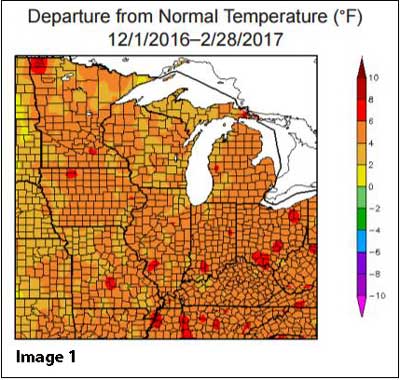
- Above average temperatures through the winter and early spring would be expected to increase nitrification rates, converting ammonium to nitrate in the soil profile.
- Nitrate-nitrogen is vulnerable to losses due to leaching and denitrification, especially under the heavy rains and saturated soil conditions experienced over the past two weeks.
- N-Watch™ is a valuable tool to monitor soil ammonium and nitrate in the upper two feet of the soil profile.
- Armed with good soil nitrogen data, you can make better decisions about how to manage nitrogen responsibly and profitably.
Temperatures across the Midwest region in the quarter ending in February 2017 averaged 2 to 6° F above normal, with the 9th warmest January and the warmest February on record (see Image 1). In fact, many retailers and farmers were actively applying spring anhydrous in the month of February. Soil temperatures at 4" under bare soil were already approaching or even above 50 degrees F by the last week of February across the central and southern 2/3 of Illinois. March was well above average on precipitation and cooled back to more normal temperatures, which brought 4" bare soil temperatures back down a few degrees across the region. April returned to above normal temperatures and below normal precipitation, with soil temperatures rising well above 50° F across much of the Midwest by the end of the month (see Image 2). In total, the period from December 2016 through April 2017 could be characterized as considerably warmer than normal with average precipitation. So what does this mean for the fate of fall-applied or early spring-applied nitrogen?
Soil temperatures above 50° F and adequate but not saturated soil moisture levels generally support high rates of nitrification, which is the biological transformation from ammonium (NH4+) to nitrate (NO3-). Under the conditions described above, we would expect to find a higher-than-normal proportion of nitrogen in the NO3- form at this stage of the growing season. Spring 2017 N-Watch™ data from the FS System has generally validated this expectation. About 60% of the available plant nitrogen remained in the upper 12" of soil, but 73% of that nitrogen had converted to the NO3- form.
Ammonium (NH4+) is positively charged, available for plant uptake, held by the soil cation exchange capacity, and not subject to loss. Nitrate (NO3-) is also available for plant uptake, but is subject to loss from the cropping systems via downward movement of water (leaching) and via nitrate respiration by microbes (denitrification). With nitrification conversion well ahead of the normal schedule, we were positioned for risk of nitrogen losses heading into these last 2 weeks of extreme precipitation, which totaled multiple inches across many parts of the Midwest. So what is the expected result of all this rainfall and flooding?
Cooler air temperatures and saturated soils have slowed corn emergence and growth to a crawl. Early vegetative-stage corn also doesn't utilize large amounts of nitrogen, so nitrogen uptake by the crop is limited in the first 30 days after planting. In deep and loosely textured soils with tile drainage, we would expect substantial leaching of NO3--N deeper into the soil profile and potential losses from the system via tile water. In tightly textured soils with poor internal drainage and higher soil temperatures, or in flooded areas of standing water, we would expect significant nitrogen losses via denitrification, as the microbes use NO3- as a substitute for oxygen in respiration. And we will see some combination of both across most soil types. So where does that leave us on nitrogen for the 2017 corn crop?
The answer is difficult to predict, but the conditions would lead us to be concerned about running short on available nitrogen during the critical late vegetative growth stage and into pollination. We can use predictive models, like the Climate FieldView™ nitrogen monitoring feature, to help us anticipate potential shortfalls. But the N-Watch™ program allows us to validate the computer models and know with measured certainty exactly where we stand on nitrogen at any given time. Soil samples are pulled via template across the zone of nitrogen application and composited for each of the 0-12" and 12-24" depths of the soil profile. Samples are analyzed for both NH4+-N and NO3--N to provide insights on where the nitrogen has moved, the relative proportions of each form, and how much total available nitrogen is left for the crop to utilize. The data can be used to make informed nitrogen management decisions that are both environmentally responsible and profitable. The FS System is proud to support the N-Watch™ program for soil nitrogen monitoring, as part of our commitment to 4R nutrient management. Please see the FS N-Watch™ website for more information and contact your FS Crop Specialist to initiate N-Watch sampling on your farm today.

Image 1. Average air temperatures Dec 1, 2016 through Feb 28, 2017 (Midwest Regional Climate Center).
Image 2. Seven-day 4” bare soil temperatures as of 5/2/2017 (Regional Mesonet Program).